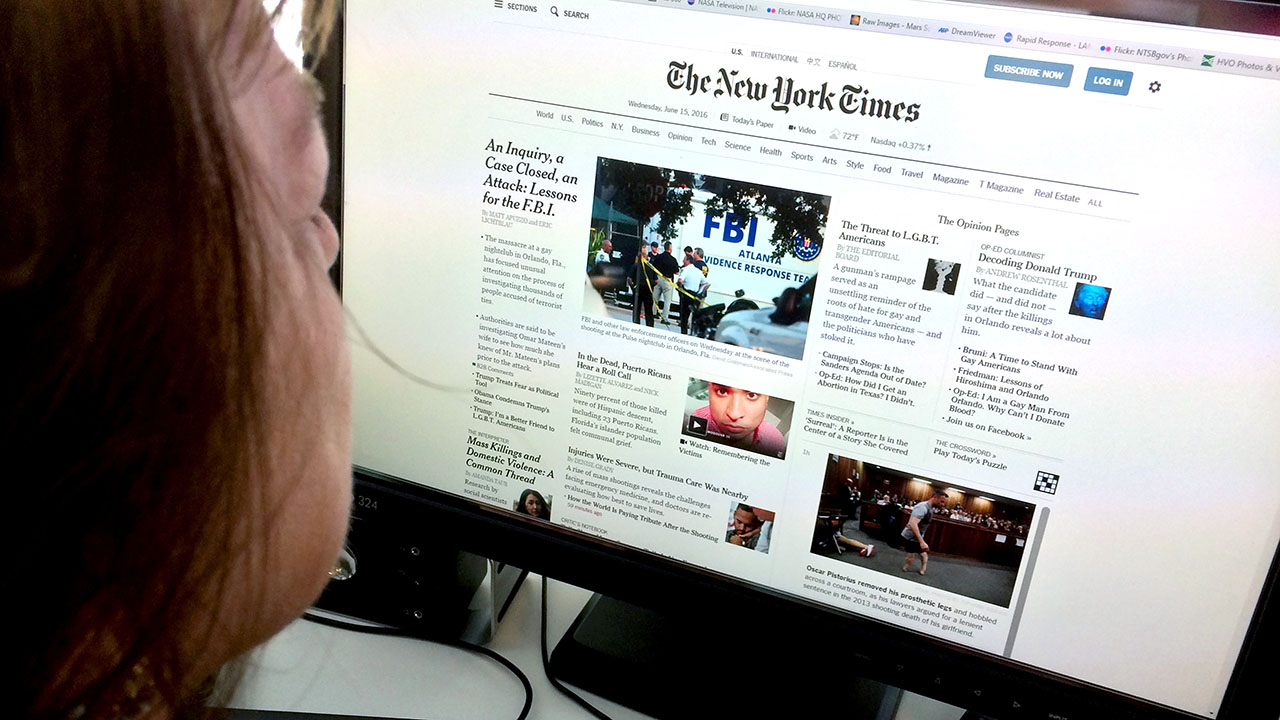Behind the Scenes at How stnews.live Delivers News
The Impact of Social Media heading We Take In News Online
Social media site has actually essentially transformed news usage. It offers prompt accessibility to information, typically overshadowing traditional media electrical outlets. Nonetheless, this rapid dissemination features difficulties. Users encounter the risk of encountering misinformation and becoming entraped in resemble chambers. The formulas driving tailored web content can cover diverse viewpoints. As these characteristics advance, comprehending their implications comes to be vital for notified involvement in public discussion. What strategies might assist browse this complex landscape?
The Development of News Usage in the Digital Age
As modern technology advanced, the way individuals consumed news changed significantly in the digital age (stnews.live). Standard papers and transmitted media began to decrease as the net emerged as a primary resource of details. Online systems provided immediate access to newspaper article, video clips, and podcasts, enabling individuals to remain informed any time. The convenience of smart phones further increased this change, allowing individuals to obtain updates on the go
In addition, the increase of news collectors and sites assisted in the usage of varied viewpoints, empowering users to customize their news consumption based on individual interests. This evolution likewise prompted wire service to adapt their methods, concentrating on electronic content and appealing readers via multimedia styles. Because of this, the typical obstacles of time and space in news shipment lessened, causing a much more prompt and individualized news experience for audiences worldwide.
The Duty of Social Network Operatings Systems in News Circulation
Social network platforms have transformed news circulation by providing instant accessibility to information. Their algorithm-driven material curation often prioritizes involvement over accuracy, leading to considerable reliability difficulties (stnews.live). As users navigate this landscape, the effects for news intake and public discussion ended up being significantly complex
Immediate News Gain Access To
Although conventional news electrical outlets have long been the primary resource of info, the increase of social media platforms has actually dramatically changed how news is accessed and eaten. Instant news access has actually come to be a characteristic of the digital age, allowing customers to obtain updates in real time. Platforms such as Twitter, Facebook, and Instagram allow news to spread swiftly, commonly exceeding conventional media in rate and reach. Individuals can share tales, discuss occasions, and engage with journalists, creating a dynamic interaction in between the audience and news web content. This immediacy cultivates a culture of seriousness, motivating customers to seek details swiftly. As a result, the expectation for prompt news has improved journalistic methods, compelling news companies to adjust their techniques to satisfy the needs of a hectic digital atmosphere.
Algorithm-Driven Web content
While customers actively involve with web content on social media sites, the algorithms that regulate these platforms play a critical role in identifying which news stories acquire presence. These algorithms assess individual actions, preferences, and interaction metrics to curate customized news feeds. Therefore, particular tales might be enhanced while others stay obscure, commonly prioritizing sensational or trending topics over substantive reporting. This selective exposure shapes users' perceptions of existing events and affects public discourse. Furthermore, the reliance on algorithm-driven web content can create resemble chambers, where customers are primarily subjected to viewpoints that align with their very own beliefs. The characteristics of news circulation on social media systems considerably influence how people take in and interpret info in the digital age.
Credibility Challenges
As customers significantly transform to social networks for news, the integrity of information come across on these systems becomes a pressing problem. The decentralized nature of social media sites allows anyone to release material, usually blurring the lines in between reliable journalism and false information. Algorithms focus on engagement over precision, causing the extensive circulation of mind-blowing or misleading tales. This environment presents substantial difficulties for customers attempting to determine reliable resources. Social network platforms, while venturing to combat misinformation through fact-checking and content moderation, face criticism for incongruities and biases in their approaches. Eventually, the obligation exists with customers to critically assess the news they take in, as the fast spread of details commonly surpasses verification efforts by platforms.
The Increase of Resident Journalism and User-Generated Content
The rise of citizen journalism has actually equipped daily people to share news and point of views, frequently supplying understandings that typical media may overlook. This shift also presents considerable difficulties, particularly the spread of misinformation that can arise from unverified web content. As user-generated content comes to be extra widespread, the equilibrium in between authentic voices and accuracy in coverage continues to be an essential problem.
Encouraging Daily Voices

Challenges of False information
While the increase of person journalism has opened opportunities for diverse voices in the media landscape, it has actually likewise introduced substantial challenges associated with false information. The ease of sharing information with social media sites platforms enables people to share news quickly, but this fast spread often comes with the price of precision. User-generated material often lacks the rigorous fact-checking and editorial oversight that standard journalism supplies. As a result, sensationalized or incorrect stories can get grip, misleading audiences and shaping public understanding (stnews.live). Furthermore, the mixing of point of view and reality within social media sites makes complex the difference between credible information and false information. Consequently, consumers have to navigate an increasingly complicated media atmosphere, requiring critical assuming skills to recognize trusted news resources in the middle of the noise

False information and Its Effects for Public Discussion
As social networks platforms significantly dominate the landscape of information dissemination, the proliferation of misinformation positions significant challenges for public discourse. False information, usually made to misguide or provoke emotional responses, can misshape assumptions of fact and weaken count on credible resources. This phenomenon results in polarized perspectives, as individuals gravitate towards resemble chambers that enhance their ideas, even more entrenching divisions within culture.
The ramifications for public discussion are extensive. When people rely upon incorrect information, purposeful dialogue diminishes, and the democratic process suffers. Moreover, false information can provoke fear and confusion, affecting public wellness, safety and security, and political security. Consequently, cultivating media literacy ends up being necessary, equipping people to seriously evaluate details and discern fact from fiction. Addressing the challenges positioned by misinformation is important for protecting the honesty of public discussion and making certain an educated people efficient in participating in positive discussions.
The Influence of Algorithms on News Exposure
Provided the main function of algorithms in establishing material exposure, their influence on news usage is profound. These algorithms, made use of by social media sites systems, prioritize certain kinds of content based upon customer interaction and preferences. Consequently, news write-ups that line up with preferred fads or audience passions are much more likely to be presented prominently, while less marvelous tales may be neglected. This develops an environment where customers are exposed mostly to info that reinforces their perspectives, potentially bring about resemble chambers.
Moreover, the constant development of formulas indicates that news companies must adjust their strategies to align with these transforming parameters, typically focusing on clickbait read or mentally billed headlines. see this website The integrity of news reporting can be compromised, as essential tales may not get the presence they deserve. The algorithmic shaping of news presence for that reason plays an essential function in affecting public assumption and understanding of existing events.
The Shift Toward Visual Narration in News Media
Increasingly, news media is accepting aesthetic narration as an effective device to involve target markets. This strategy leverages pictures, video clips, infographics, and interactive aspects to share details extra effectively than conventional text-based layouts. As attention spans shorten, visuals offer a quick, impactful way to communicate complex stories and order visitors' interest.
Platforms like Instagram and TikTok have further accelerated this fad, engaging news companies to adapt their web content methods to fit these visually-driven settings. By integrating engaging visuals, news electrical outlets can improve emotional connections and foster higher understanding of topical concerns.
Visual narration allows for more varied stories, showcasing numerous viewpoints via dynamic discussions. As audiences significantly consume news via smart phones, the shift towards visuals not only provides to individual preferences but additionally aids to break down obstacles to info access. Eventually, this evolution shows a broader transformation in just how news is created and eaten in the electronic age.
Future Trends: Browsing the Transforming Landscape of News Intake
While the digital landscape proceeds to develop, news consumption is positioned for significant change driven by arising modern technologies and altering target market habits. As expert system and artificial intelligence advance, customized news feeds will certainly come to be much more widespread, permitting users to get content tailored to their passions. This modification might result in greater interaction yet additionally raise concerns about resemble chambers and false information.
Moreover, the rise of voice-activated tools and clever speakers will certainly affect just how news is provided, moving the emphasis from visual to acoustic styles. This trend may motivate wire service to embrace even more succinct and interesting audio material.

Regularly Asked Concerns
How Do Social Network Communications Affect News Trustworthiness?
Social media interactions can substantially affect understandings of news reputation. Interaction metrics, such as likes and shares, usually shape target market count on, with popular messages obtaining regarded authenticity, no matter the accuracy or integrity of the info presented.
What Duty Do Influencers Play in Shaping News Narratives?
Influencers substantially form news stories by leveraging their systems to intensify specific stories, usually customizing content to their target market. This can result in prejudiced perspectives, affecting public perception and focusing on sensationalism over accurate reporting.
Exactly How Can Users Identify Reliable News Resources on Social Media?
Individuals can recognize reliable news sources on social media sites by examining the resource's reputation, validating truths via several electrical outlets, examining the professionalism and reliability of the content, and acknowledging prospective predispositions in reporting to assure precise info.
What Influence Does Social Media Carry Standard Journalism Jobs?
Social media site considerably influences traditional journalism jobs by modifying earnings versions, minimizing need for print media, and fostering competitors from resident journalists. Subsequently, lots of specialists face job insecurity and should adjust to quickly altering media landscapes.
Just How Do Various Demographics Consume News on Social Media?
Different demographics exhibit varied preferences for news consumption on social media. Younger audiences favor platforms like TikTok and Instagram for quick updates, while older individuals tend to prefer Facebook and Twitter for more comprehensive conversations and articles.